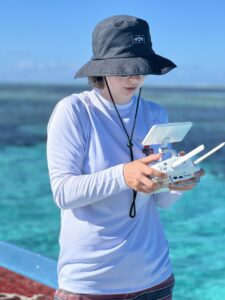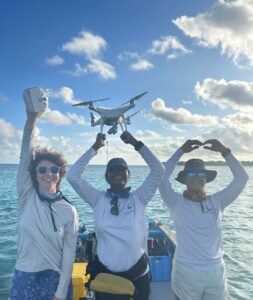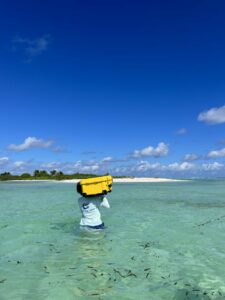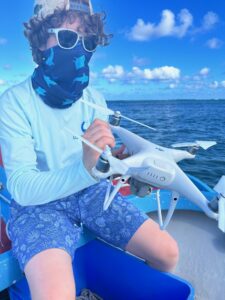Wind, water, and wobbly boats: flying drones in the atoll
Hi! I’m Daisy, an MSc student from the University of Kent in the UK, working with the D’Arros Research Centre to assess juvenile green and hawksbill sea turtle populations in St Joseph Atoll.
I’ve been lucky enough to recently spend a month on D’Arros Island, working within the atoll conducting drone surveys for my research project. UAV research provides fantastic opportunities for low-cost, non-invasive observations of wildlife. Whether it’s habitat use, behaviour, or for conducting population abundance surveys. However, it’s not without its challenges. Despite my initial expectations, flying the drone was the easy part. The take off and landings, however, are a little more complicated. Wind, water, and wobbly boats can lead to real challenges when taking a drone off while it’s held above your fellow researcher’s head. But, once the drone is in the air and the transect is running, I get the chance to sit back and take in where I am. St Joseph Atoll is unlike
anywhere I’ve ever been. The pristine environment, free from human pressure is brimming with wonderful marine life, healthy coconut forests, and the clearest water I have ever experienced.
Over the month I spent on D’Arros, we took many trips to the atoll to get to our end goal of 120 transects. These were spread across 30 sites, totalling 240km flown by the little drone! The first two weeks of field work went smoothly, with the transect data providing high counts of turtles, and the drone flights going to plan. Minus the occasional down pour of rain which required a quick return to the boat for the not so waterproof drone. But generally, UAV surveying is a smooth-running operation.
Then came the battle with low tides, wind, and big waves. Entering the atoll could be a struggle when tides were low, due to getting through the channel that feeds into the central lagoon. Same for needing to access the transects stationed south of St Joseph Island. These areas of reef flat sand and seagrass, where the water is less than half a metre deep called for some improvisation! This is the part where I give a big thank you to the incredible research officers Dyllis and Ellie, and research intern Kimberlie of the DRC team, who agreed to help me carry the drone box the length of St Joseph beach. Due to the transects being inaccessible by boat, carrying the box at 4 o’clock in the morning seemed like a great idea. But it was worth it, two more transects done and a step closer to completing my field work. Plus, who doesn’t want to stand on the beach of an uninhabited island waiting for the sun to fully rise? When you’re watching a young honeycomb moray eel making its way out of the rock pools as the tide came in, you can’t complain.
From there I made strong progress in collecting the drone footage I needed, and processing the turtle counts once back on dry land. That was until we hit wind and boat troubles a few days later. A broken boat engine taught me that even with straight forward methods of research, you must be well prepared, and ready to think on your feet. Like thinking that carrying a relatively heavy drone box across the shallow water to shore, only to find out that the transect was in fact a lot further away than I had first anticipated, would be a good idea. Or, when the combination of low tides and high winds, presented the solution of heading to the south of the atoll in deeper water to be able fly the drone in. I didn’t foresee the terrible combination of staring at a small screen and rocking dramatically back and forth. Needless to say, the feeling of sea sickness came pretty quickly!
But all these challenges are what made my research experience so memorable, and such a learning opportunity. Being able to adapt and to problem solve, are such important qualities when conducting field work. This experience, and the staff that I had the privilege to work with at the DRC, showed me that no matter what nature throws your way, you can find a way around it to get the job done. I had the most incredible experience at D’Arros and within the atoll, both educationally, and personally. I had a chance to learn new skills and grow my experience and understanding of marine research. But best of all, to clearly see the direction I want my career to take. To continue exploring the ways we can learn more about our oceans and the fantastic creatures that call them home. So, whether that be under the water, or way above it, new discoveries and hard work provide us with the conservation breakthroughs we need, to save our seas.




